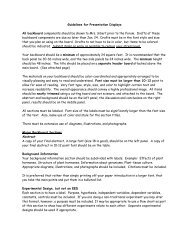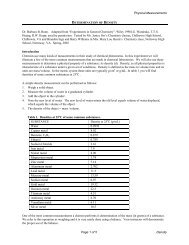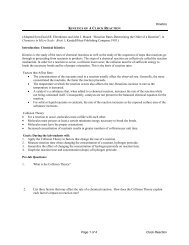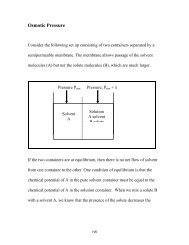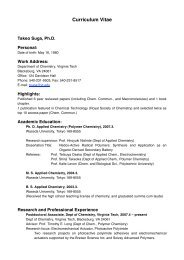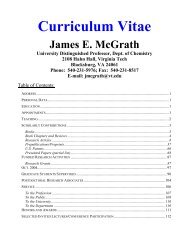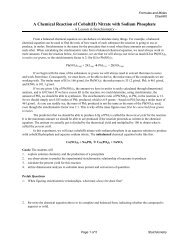Carlier Group Gaussian User Manual - Virginia Tech
Carlier Group Gaussian User Manual - Virginia Tech
Carlier Group Gaussian User Manual - Virginia Tech
You also want an ePaper? Increase the reach of your titles
YUMPU automatically turns print PDFs into web optimized ePapers that Google loves.
<strong>Carlier</strong> <strong>Group</strong> <strong>Gaussian</strong> <strong>User</strong> <strong>Manual</strong> 9<br />
# If you want to use a Palm device with Linux, uncomment the two lines<br />
below.<br />
# For some (older) Palm Pilots, you might need to set a lower baud rate<br />
# e.g. 57600 or 38400; lowest is 9600 (very slow!)<br />
#<br />
#export PILOTPORT=/dev/pilot<br />
#export PILOTRATE=115200<br />
test -s ~/.alias && . ~/.alias || true<br />
alias newzmat='/apps/packages/gaussian09a02/g09/newzmat'<br />
alias freqchk='/apps/packages/gaussian09a02/g09/freqchk'<br />
umask 027<br />
Basically the .bashrc file is hidden and to see it you will need to invoke ls –a. You can<br />
edit it with the vi text editor. Note—before modifying it would be good to copy the<br />
original file to another file name just in case you mess it up. Then, to make the change<br />
in the .bashrc file active, either log-off and log on again, or type !source and the<br />
modified .bashrc file will be read<br />
pcarlier@charon1:~> !source<br />
source .bashrc<br />
Note that the alias gives the complete routing of the newzmat and freqchk commands.<br />
If you fail to set these aliases, and type “freqchk” you will get the response “command<br />
not found.” If you want to conveniently use other <strong>Gaussian</strong>09 utilities, you can create<br />
the corresponding aliases in your .bashrc file. Thanks to Ryan Fortenberry (Crawford<br />
<strong>Group</strong>) for helping me with this!<br />
I. <strong>Group</strong> Shared Directory<br />
We have a shared directory at /home/PRC, and current g09 users in our group should<br />
be members of the group prc and thus should have access to it. I have placed awk<br />
scripts and other useful files here. Worth copying to your run directory right away are:<br />
header<br />
testE.gjf<br />
testE.sh<br />
unixdosconvert.awk<br />
enantiomer.awk<br />
You can check membership of the group prc by the following command:<br />
getent group prc<br />
You can identify a person’s full name from their PID, e.g. “pcarlier” by the command by



